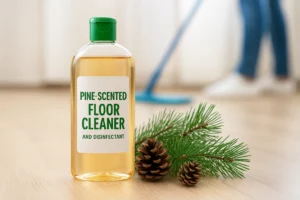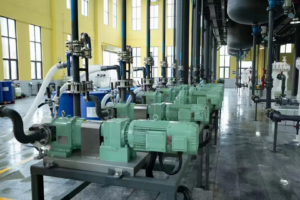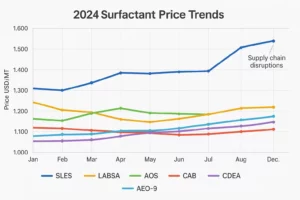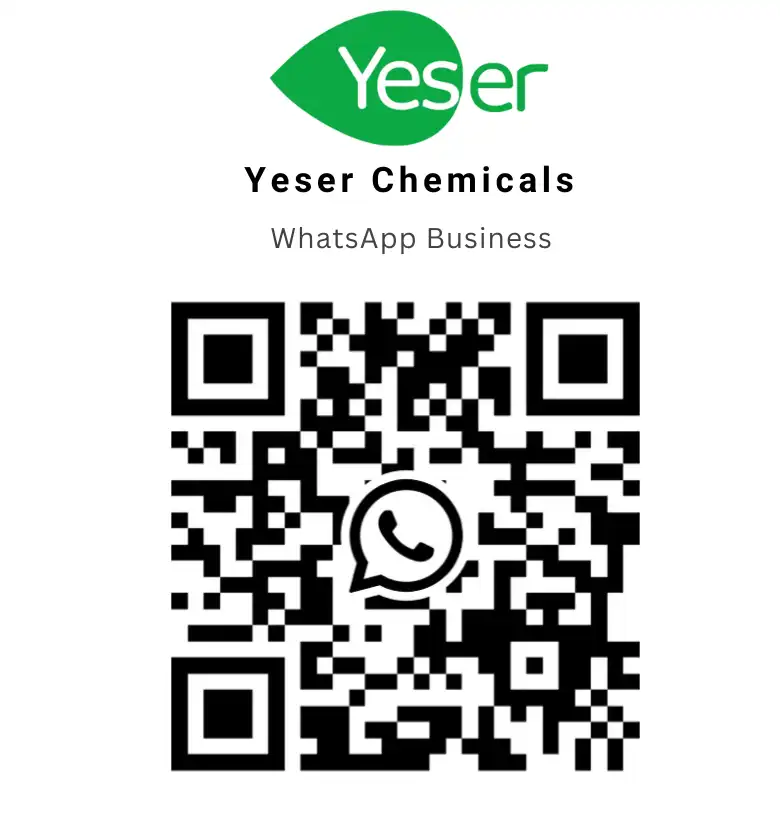Introduction
Shampoo is one of the most widely used personal care products. To produce high-quality shampoo, using the right ingredients in the proper proportions is essential. Among all the ingredients in shampoo, surfactants are the core ingredients, as they contribute most to the fundamental function of shampoos, which is cleaning our hair and scalp.
Surfactants in shampoos help to clean our hair and scalp by acting as a foaming agent and cleansing agent. Surfactants can create a rich lather when the shampoo is applied for hair washing, and the lather helps distribute the shampoo evenly through the hair, ensuring that all parts of the scalp and hair are cleaned thoroughly. Surfactants act as a cleansing agent in the way of lowering the surface tension of water and their hydrophobic tails bind to the dirt and grease, while their hydrophilic heads interact with the water in the cleaning solution. This combination allows surfactants to emulsify and lift off dirt and grease particles from our hair and scalp, effectively cleaning it.
Surfactants can also contribute as a conditioning agent and a shampoo body texture enhancer.
However, so many surfactants are available on the market, and not all surfactants are created equal. Choosing the right one can make all the difference. This article will discuss how to choose the best surfactants for shampoo manufacturing.
Understanding Surfactants
Surfactants, short for “surface active agents,” are compounds that are used in a variety of applications to reduce the surface tension between two different substances. They have both hydrophilic (water-loving) and hydrophobic (water-fearing) properties, which allows them to interact with both water and oil-based compounds.
Surfactants can be found in many everyday products, such as detergents, shampoos, soaps, and cleaning agents. They are also widely used in the industries of food, pharmacies, plastics, paper, and textiles. Surfactants can be classified into four main categories: anionic, cationic, nonionic, and amphoteric.
Anionic Surfactants
Anionic surfactants are surfactants that have a negatively charged functional group, and they are the most common type of surfactant used in shampoo manufacturing. They are known for their strong cleaning ability and lathering properties. Examples of anionic surfactants used in shampoo include sodium lauryl sulfate (SLS) and sodium laureth sulfate (SLES). However, these surfactants can be harsh on the scalp and hair, leading to dryness and irritation. So in recent years, there is a trend of replacing SLS and SLES with more gentle anionic surfactants, such as amino acid surfactants, to achieve ‘sulfate-free’ shampoos.
Cationic Surfactants
Contrary to Anionic surfactants, Cationic surfactants are positively charged. They have good bactericidal and anti-static properties. So they are commonly used as a disinfectant and conditioning agent in a variety of home care and personal care products. Typical Cationic surfactants include Cetyltrimethylammonium chloride and Benzalkonium chlorid.
However, Cationic surfactants will interact with the Anionic surfactants and, in many cases combine to form an insoluble salt. So in shampoo formulations, where Anionic surfactants commonly exist, traditional Cationic surfactants can not be used. Cationic polymers are used in this case to offer conditioning properties and to formulate 2-in-1 shampoos.
Nonionic Surfactants
Nonionic surfactants do not carry an electrical charge and they are generally less harsh than other types of surfactants. They are used in shampoo and other personal care formulations for their mildness and their outstanding ability to create a rich and creamy lather. Additonaly, Nonionic surfactants often have good thickening ability which can help to build a thick body texture for the shampoo. Examples of nonionic surfactants used in shampoo include cocamide DEA and Cocamide MEA.
However, there are some Nonionic surfactants that don’t have these favorable properties to use in shampoos. They are Alcohol ethoxylates(common examples are AEO-7 and AEO-9) and Alkylphenol ethoxylates(common examples are NP9 and NP10). They are harsh on the skin; they are defoaming; and they do not help to thicken a solution.
Amphoteric Surfactants
Amphoteric surfactants, also known as zwitterionic surfactants, have both positive and negative charges and can behave as either anionic or cationic, depending on the pH of the solution.
They are becoming more commonly used in shampoo formulations and other personal care products, due to their ability to decrease the irritancy of the formulation while increasing the active content level. Amphoteric surfactants also provide thickening and conditioning properties.
Examples of Amphoteric surfactants commonly used in shampoo include Cocamidopropyl Betaine, and Cocamidopropylamine Oxide.
Factors to Consider When Choosing Surfactants
When selecting surfactants for shampoo manufacturing, it is essential to consider several factors, including:
Cleansing performance
Surfactants are primarily responsible for cleansing the hair and scalp. Therefore, it is important to choose a surfactant that can effectively remove dirt and grease from our hair and scalp yet without leaving the hair feeling dry or stripped.
Foaming performance
The foam produced by the surfactant helps distribute the shampoo through the hair and scalp evenly and holds dirt and oil in suspension for easy rinse offer with water. A rich foam also provides a pleasant user experience. Therefore, a surfactant that produces a rich and stable foam is desirable.
Mildness
Some surfactants can potentially cause irritation to the skin, scalp, and eyes, so it’s crucial to choose a mild surfactant that is gentle and non-irritating. Sodium lauryl sulfate or SLS has excellent foaming and cleansing properties and was once a top choice as a shampoo surfactant. However, in recent years, it’s been increasingly criticized to be irritating, and its place has been taken by milder alternatives including Sodium laureth sulfate(SLES), Alpha Olefin Sulphonate, and Amino acid surfactants.
Thickness and Viscosity
Thickness and viscosity determine the body texture of a shampoo, which is very crucial for the success of a shampoo product. A proper thick and viscous body is good for applying the shampoo to our hair and it also gives the consumer a good aesthetic appearance, which enhances his/her confidence in its hair-washing performance.
The choice of surfactants affects the thickness and viscosity of the shampoo. Thicker shampoos usually contain surfactants of higher molecular weight. Cetyl alcohol and Cetearyl alcohol are commonly added as thickeners. Some surfactants such as Cocamide DEA(CDEA), Cocamide MEA(CMEA), and Cocomidopropyl Betaine(CAPB) can also help to build viscosity through surfactant synergy effects.
Compatibility
Commonly, more than one surfactants are present in a shampoo formulation for surfactant synergy to achieve the best overall performance at a lower cost. It’s essential to ensure different surfactants are compatible with each other. As here above mentioned, Cationic surfactants are not compatible with Anionic surfactants.
Surfactants must also be compatible with other ingredients in the shampoo formulation, such as thickeners, conditioners, and preservatives.
Cost
As surfactants usually take up the largest portion of a shampoo formula. The cost of the surfactant can largely impact the overall cost of the shampoo, so it’s important to choose a surfactant that provides good value for money.
Environmental impact
Some surfactants can have negative environmental impacts, such as being toxic to aquatic life, being hard to degrade in nature, or using unsustainable sources. Therefore, it’s important to choose a surfactant that is environmentally friendly.
Regulatory compliance
The use of certain surfactants may be restricted or prohibited by regulations, so it’s essential to choose a surfactant that is compliant with relevant regulations. A good place for checking the potential use restrictions of a surfactant(or any other ingredient) in personal care products is the Environmental Working Group(EWG).
Performance under different conditions
Different surfactants may perform differently under various conditions, such as pH range, hard/soft water, or in different temperatures, so it’s important to consider the intended use and the specific properties of the surfactant for optimal performance.
Popular Surfactants Used in Shampoo Manufacturing
Some of the most commonly used surfactants in shampoo manufacturing are:
- Sodium Lauryl Sulfate (SLS) – This is a highly effective anionic surfactant that produces a rich, dense foam. Due to its potential irritation, it’s being less and less used in shampoos.
- Sodium Laureth Sulfate (SLES) – This is currently the most widely used surfactant in shampoos. It’s a milder derivative of SLS, but still produces a good lather. SLES is highly cost-effective and highly accessible.
- Ammonium Lauryl Sulfate (ALS or AESA) – It has very similar foaming, emulsifying, and cleaning properties to SLES, but with better solubility in water. Better solubility makes it easier to rise off and leaves less residue in washing.
- Sodium Lauroyl Sarcosinate – This is a trending Amino acid-based anionic surfactant with good foaming and cleansing ability and outstanding mildness. It’s currently the most accessible amino acid surfactant in most places.
- Cocamidopropyl Betaine – This is an amphoteric surfactant that is mostly used as a secondary surfactant in shampoo. It is derived from coconut oil, readily biodegradable, and gentle on the skin. It also has outstanding foaming ability and can achieve a good synergy effect with SLES to thicken the shampoo.
- Decyl Glucoside – This is a non-ionic surfactant that is derived from corn and coconut. It is super gentle on the skin and is often used in natural and organic shampoos.
- Sodium Cocoyl Isethionate – This is a gentle, sulfate-free surfactant that is derived from coconut oil. It produces a creamy lather and is often used in baby shampoos and other gentle formulas.
- Sodium Lauroyl Methyl Isethionate – This is a gentle, sulfate-free surfactant that is derived from coconut oil. It is often used in clarifying shampoos and other products that need to remove build-up from the hair.
It’s important to note that some of these surfactants may be harsher than others, and different individuals may have different sensitivities to them. Some people may prefer to use sulfate-free shampoos, which use gentler surfactants or none at all.
Conclusion
Choosing the right surfactants is essential for producing high-quality shampoo. Consider factors such as performance, mildness, cost, compatibility, hair type, formulation, environmental impact, and regulatory requirements when choosing surfactants for your shampoo. By carefully selecting the right surfactants, you can create a shampoo that effectively cleanses and nourishes the hair while being gentle on the scalp and the environment.






